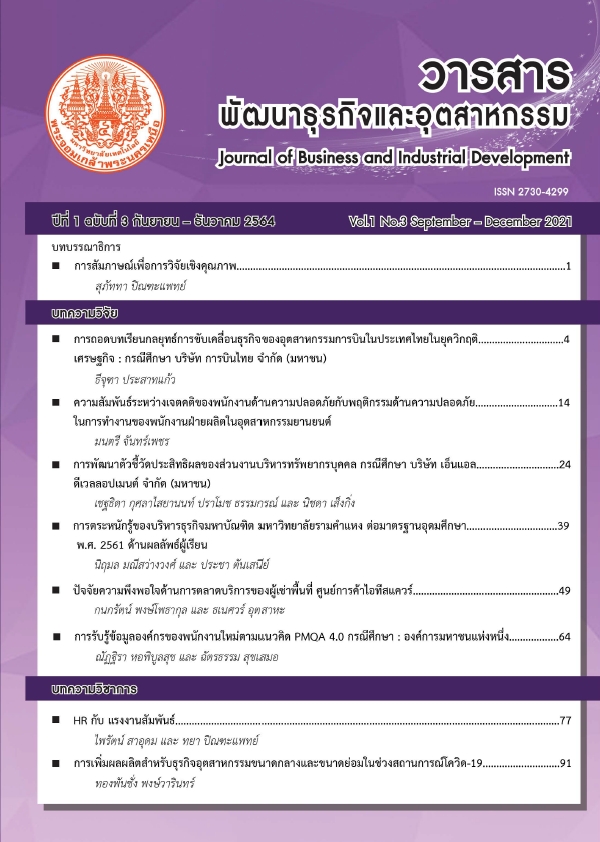การพัฒนาตัวชี้วัดประสิทธิผลของส่วนงานบริหารทรัพยากรบุคคล กรณีศึกษา บริษัท เอ็นแอล ดีเวลลอปเมนต์ จำกัด (มหาชน)
คำสำคัญ:
การพัฒนา, ตัวชี้วัดประสิทธิผล, ทฤษฎีการประเมินแบบสมดุลบทคัดย่อ
การวิจัยนี้เป็นการวิจัยเชิงคุณภาพมีวัตถุประสงค์ 1) เพื่อศึกษาลักษณะขององค์กร ตัวชี้วัดประสิทธิผลการวิเคราะห์สภาพแวดล้อมและศักยภาพ และการประเมินแบบสมดุล (Scorecards) ของฝ่ายทรัพยากรมนุษย์ปี 2562 2) เพื่อพัฒนาตัวชี้วัดประสิทธิผลของส่วนงานบริหารทรัพยากรบุคคล กลุ่มตัวอย่างที่ใช้ในการศึกษา คือ พนักงานในส่วนงานบริหารทรัพยากรบุคคล จำนวน 7 คน โดยเป็นการเลือกแบบเฉพาะเจาะจง เครื่องมือที่ใช้ในการศึกษา คือ แบบสัมภาษณ์แบบมีโครงสร้าง ผลการศึกษาพบว่า การพัฒนาตัวชี้วัดประสิทธิผลของส่วนงานบริหารทรัพยากรบุคคล 4 มุมมองตามทฤษฎีการประเมินแบบสมดุล (Balanced Scorecard Theory) ประกอบด้วยตัวชี้วัด 27 ตัวชี้วัด 4 ด้านมุมมอง ดังนี้ 1) ด้านการเงิน มี 3 ตัวชี้วัดสำคัญ ได้แก่ 1.1) การควบคุมงบประมาณค่าบุคลากรของส่วนบริหารทรัพยากรบุคคลให้มีประสิทธิภาพ 1.2) การควบคุมงบประมาณค่าดำเนินการของส่วนบริหารทรัพยากรบุคคลให้มีประสิทธิภาพ และ 1.3) การลดต้นทุนในอัตราการจ้าง 2) ด้านลูกค้ามี 3 ตัวชี้วัดสำคัญ ได้แก่ 2.1) ความพึงพอใจของผู้ใช้บริการด้านสวัสดิการ 2.2) ความพึงพอใจของผู้เข้าร่วมฝึกอบรมและพัฒนา และ 2.3) การประเมินความพึงพอใจในการส่งมอบแรงงาน 3) ด้านกระบวนการภายในมี 18 ตัวชี้วัดโดย 3 ตัวชี้วัดที่สำคัญ ได้แก่ 3.1) การดำเนินการสรรหาบุคลากรในตำแหน่งงานตามแผนงบประมาณและแผนกำลังคน 3.2) การตรวจสอบคุณสมบัติของผู้สมัครที่ผ่านการคัดเลือกก่อนการเริ่มงาน และ 3.3) ความถูกต้องครบถ้วนของข้อมูลการจัดทำค่าตอบแทนและสวัสดิการ และ 4) ด้านการเรียนรู้และพัฒนามี 3 ตัวชี้วัดสำคัญ ได้แก่ 4.1) การดำเนินงานด้านระบบการจัดการคุณภาพ (ISO 9001 : 2015) ตามแผนงาน 4.2) การส่งเสริมบุคลากรให้รับรู้และเข้าใจในค่านิยมร่วมขององค์กร และ 4.3) การนำสื่อดิจิทัลเพื่อส่งเสริมและสนับสนุนการพัฒนาความสามารถของบุคลากรในยุค 4.0
เอกสารอ้างอิง
Meesuttha, A. (2011). Performance Appraisal (Revised Version), (18th ed.). Bangkok: Technology Promotion Association (Thailand-Japan).
Kaplan, R.S. and Norton, D. P. (1996). The Balanced Scorecard: Translating Strategy into Action. Boston: Havard Business School.
Kittiwimonchai, P. (2013). Performance Indicator Development of Supporting Organization Under the Office of the President, Khon Kaen University. Received Funding for an Institute Research Project Khon Kaen University.
วิโรจน์ ลักขณาอดิศร. (2009). หลุดจากกับดัก : Balanced Scorecard, กรุงเทพมหานคร : บมจ. ซีเอ็ดยูเคชั่น.
Kittiwimonchai, P. et al. (2012). Education to Define Outcome Indicators (KPI) Based on Educational Standards for Excellence and Discipline in Bringing an Actionable Education Guide to Practice. Received Funding for an Institute Research Project Khon Kaen University.
Sacchanand, C., & Prommapun, B. (2011). Development of Standards and Indicators of Living Library Operations Model of Learning Park. MANUTSAT PARITAT: Journal of Humanities, 33(2), 1-18.
Prasoetthap, V. (2019). Development of Audit Quality Indicators to Enhance Audit Quality of Thai Audit Firm to Universal Standard. Romphruek Journal, 37(1), 55-65.
Hinkaew, W. (2010). The Key Performance Indicators for Building Inspectors. [Unpublished master’s thesis]. Silpakorn University.
Paepong, A. (2014). A Study on Influence of Personal Factors, Balanced Scorecard, and Teamwork on Work Effectiveness of Operational Staff in Silom Business District. [Unpublished master’s thesis]. Bangkok University.
Jujia, S., & Mungsing, S. (2017). The Development of Quality Indicator of Learning Object. KKU Research Journal of Humanities and Social Sciences (Graduate Study), 5(3), 57-68.
ดาวน์โหลด
เผยแพร่แล้ว
รูปแบบการอ้างอิง
ฉบับ
ประเภทบทความ
สัญญาอนุญาต

อนุญาตภายใต้เงื่อนไข Creative Commons Attribution-NonCommercial-NoDerivatives 4.0 International License.





